About 125 million people around the world wear contact lenses as an alternative to glasses for the correction of refractive errors (spectacle numbers). Shroff Eye Centre and its dedicated staff offer you various contact lenses options including Soft contact lenses (including disposable), Toric contact lenses, Cosmetic contact lenses, Rigid Gas-permeable (semi-soft) contact lenses.
Low vision aids clinic offers rehabilitative services to patients with low vision in the form of various optical magnifiers, telescopes and electronic low vision aids.
(For further information, please refer to Frequently asked questions)
Team for Contact Lens & Low Vision Aids
Frequently Asked Questions
Contact Lenses (CL) are small, thin, curved transparent discs that are designed to rest on the cornea, the clear front surface of the eye. Contacts cling to the film of tears over the cornea because of surface tension, the same force that causes a drop of water to cling to the side of a glass. Contact lenses are mostly used to correct near-sightedness, far-sightedness and astigmatism. Contacts provide a safe and effective way to correct vision when used with care and proper supervision. They can offer a good alternative to eyeglasses, depending on your eyes and your lifestyle. However, one must remember, they are health devices, not commodities or beauty aids, and not everyone can wear them. Also, their use can affect the well being of your eyes and only an optometrist or an ophthalmologist (eye surgeon) is qualified to assess the health of your eye. Your healthy vision is the first priority.
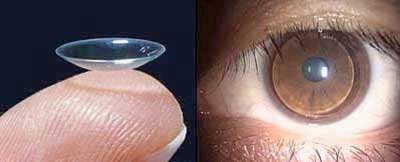
Know More...
There are basically two types of contact lenses:
1. Rigid Gas-permeable (RGP) Contact Lenses which are also known as "semi-soft lenses"
2. Soft Contact Lenses Hard Contact Lenses have become obsolete now.
Soft lenses can be further classified depending on the type of wear:
Daily wear
Extended wear
Disposable (Quarterly, Monthly, Fortnightly, Weekly and Daily)
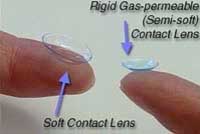
Know More...
RGP (Semi-soft) lenses: RGP lenses are made of special, firm plastics combined with other materials, such as silicone and fluoropolymers, which allow oxygen in the air to pass directly through the lens. These lenses are very durable and typically last longer than soft lenses. RGP lenses provide excellent quality of vision, have a long life, and can correct astigmatism as well as uneven curvature of the cornea. The disadvantages are that these may take a little longer to get used to, it is easier for dust to get behind RGP lenses, causing irritation and discomfort, and one can't switch back and forth with glasses as easily. However, regular wearers find them comfortable and the visual acuity outstanding.
Soft lenses are made of flexible water-absorbent (hydrophilic) material having water content between 30-80%. These lenses are comfortable the moment they are inserted in the eye. They are less likely to dislodge and can be worn for longer periods. However, their biggest disadvantage is that they cannot correct higher degrees of astigmatism. They also need to be changed more frequently.
Know More...
Each individual is different, although there are some broad guidelines that may be followed. If you are interested in initial comfort, soft contact lenses may suit you better than rigid gas permeable (RGP) lenses. On the other hand, RGP lenses tend to last longer. A soft (hydrophilic) lens is more appropriate for occasional wear (at most once or twice a week).
Not everyone can wear both types. Only after thoroughly examining your eyes and vision, can one advise whether you can wear RGP lenses, soft lenses or both. In your initial consultation, a number of tests and measurements will be performed, usually following a full, general visual examination. This evaluation will determine the optimum contact lenses for your specific needs. Additionally any other factors that determine your ability to wear lenses successfully will be explained to you.
Various general health factors, including medication, ocular, medical and family history will be assessed. A number of prescription medications, drugs and allergic factors can influence the ability to wear contact lenses successfully. Additionally your work and social environments can affect lens choice for example air-conditioning, computer use, dusty environments and so forth will affect the lens choice.
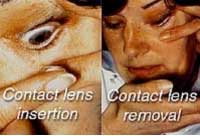
Know More...
Daily-wear contact lenses are designed to be removed each day for cleaning, and should be taken out before you sleep or nap.
Extended-wear lenses can be worn continuously for up to seven days before they are removed for cleaning, depending on how oxygen-permeable the lens material is. Extended-wear lenses can also be prescribed to be removed each day for cleaning and slept in occasionally when special circumstances arise. Many variables are considered in deciding between daily-wear and extended-wear lenses for each person's needs. Since the risk of serious eye infections is higher in extended contact-lens wearers, they are generally prescribed in carefully selected individuals who are frequently monitored by eye care professionals.
Daily-wear lenses should never be worn as extended-wear lenses. Misuse can lead to temporary and even permanent damage to the cornea. People who wear any type of lens overnight have a greater chance of developing infections of the cornea. These infections are often due to poor cleaning and lens care. Improper over-wearing of contact lenses can result in intolerance, leading to the inability to wear contact lenses.
Know More...
No, the two weeks refers to the actual amount of wearing time so they can last longer than two weeks if you are not wearing them full time.
Know More...
Most first time wearers are delighted with the level of comfort that contact lenses provide. Initial contact lens fittings by professional eye care practitioners can minimize or eliminate any irritation associated with new lenses. After a brief adjustment period, most people report they can no longer feel contact lenses on their eyes.
Know More...
With normal use, contact lenses will stay firmly in position. However, they can come out under certain conditions. High winds can cause the eyes to water and pull the eyelid tight against the eye, increasing the chance of lens loss. A sharp blow to the head may dislodge rigid gas permeable lenses. And rubbing your eye carelessly may result in a lost lens.
Describe to your eye care practitioner all of the circumstances in which you are likely to wear your contact lenses. This will help him or her prescribe a type of lens that is less likely to be dislodged given your activities.
Know More...
Your eyes and your vision are precious, and good contact lens care can help assure a lifetime of healthy eyes. It's important to follow the instructions for daily or weekly lens care prescribed by your eye care professional for your type of lenses. The basic steps include cleaning, rinsing, and disinfecting (for storing).
Cleaning solutions remove dirt, protein, oils, mucus, and debris that get on the lens during wear.
Disinfecting solutions kill bacteria and other germs on the lenses. Disinfection is necessary to help prevent serious eye infections.
Rinsing solutions remove other solutions from the lenses. They also prepare the lenses for wear.
Enzyme solutions remove protein and other deposits that accumulate on the lenses over time.
Rewetting solutions are used to wet (lubricate) the lenses while you are wearing them, to make them more comfortable.
These steps can be performed using separate solutions. However, recently, there has been a strong movement to "one-bottle" systems. These all-in-one solutions are the easiest and quickest to use. You should not make your own lens care solutions, nor should you mix different brands of solutions unless instructed by your eye care practitioner. However, if you are particularly sensitive to chemicals, it may be better to use a hydrogen peroxide system. One must remember that all contact lens cases need frequent cleaning, including disposable lens cases. As a rule never bring any contact lenses in contact with tap water as it can be source if serious (sight-threatening) eye infection.
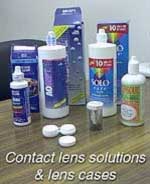
Know More...
The need to use protein remover tablets depends on the amount of protein deposits your eyes produce and how often you replace your lenses. Protein deposits are normal. But as they age, they can change in chemical composition, contributing to discomfort and poor vision or leading to allergies. Regardless of your lens replacement schedule, however, daily cleaning is important for eye health. Consult your eye care practitioner for the best advice regarding your replacement and cleaning schedules.
Weekly enzyme cleaning helps keep soft lenses free from deposits of protein naturally produced in your eyes and carried by your tears. Lately, solutions are available, which eliminate the need for enzyme cleaning as well. Soft extended-wear contacts are the most likely to have protein build-up and cause lens-related allergies. Soft daily-wear lenses are less likely to create problems. Rigid gas-permeable lenses may be good choices for someone with allergies, as less protein is deposited on the lenses. If these deposits become a problem, your eye care practitioner may recommend a type of contact lens that you replace more frequently. Depending on the replacement frequency, using a protein remover in addition to your daily cleaning regimen may not be necessary.
The type of care contact lenses require, and how long they should be worn, is something each eye care professional will prescribe for each patient. Personal wear and care regimens may depend upon the type of contact prescribed, the nature of the vision problem being corrected, and the individual's unique eye chemistry. Regardless of the type of lens you wear, you will find that lens care is now easier and more convenient than ever before.
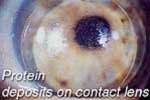
Know More...
While some cosmetics may interfere with contact lens performance and the wearer's tolerance for contacts, others are safe. Some rules should be followed when using cosmetics:
Insert lenses before applying eye makeup and take them out before removing cosmetics.
Use hair spray and other aerosols before lenses are inserted. Allow time for the aerosol mist to settle from the air or go to a different area before handling lenses.
Completely remove residual cosmetics from you hands with mild, additive-free soap before handling lenses.
Use cream shadows instead of powders and avoid using shadows with glitters.
Use water based cosmetic formulations.
Use hypo-allergenic cosmetics.
Avoid using mascaras containing fibers for extra lash length.
Avoid using saliva to wet applicators.
Don't apply eyeliners and pencils inside the upper or lower eyelid margin.
Know More...
Wearing contact lenses for sports is a more flexible and stable form of eye correction than eyeglasses, and athletes of all kinds have discovered the advantages of wearing contact lenses when participating in sports or working out. Contacts don't steam up from perspiration, don't smudge and don't get foggy if you go from cold to warm temperatures. They provide better depth perception and complete peripheral vision. Today's close-fitting contacts stay on your eyes, even during vigorous activity.
If your sport involves vigorous exercise, a soft contact lens is an appropriate choice. Your eye care practitioner can help determine the best type of lenses based on your sport or activity.
To help protect your eyes and your contacts, goggles should be worn when you swim.
Know More...
Pool water can cause discomfort due to chlorine. It is best to avoid swimming with your contact lenses on because it exposes your contacts to bacteria and other microorganisms in the water. These can adhere to your lenses and place you at risk of eye infections.
If you do swim with your lenses, you should wear goggles with a firm seal. If you don't wear goggles, the contact lenses may float from your eyes. They may also absorb the pool water, one consequence of which may be that they adhere quite firmly to the eye. If this occurs, it is advisable to leave the lenses alone for 10-15 minutes until your natural tears have replaced the water in them, before trying to remove them. You should then disinfect them immediately afterwards.
Know More...
You're less likely to have success with contact lenses than someone who does not have this condition. This does not mean that you cannot wear contact lenses at all. It simply means you may have a shorter contact lens wearing period than normal or that you may choose to wear your lenses only occasionally. You can increase the comfort of your lenses by inserting eye lubrication drops.
For the same reason, wearing contact lenses while traveling by plane can be uncomfortable. The low humidity in aircraft cabins contributes to dry eye symptoms and contact lens discomfort. It may be helpful to put lubrication drops in your eyes before you enter the aircraft, or during flight. If symptoms persist or become severe, it is probably easiest and best to wear eyeglasses when flying. As always, it is best to consult your eye care practitioner for the best advice regarding whether you should wear contact lenses and what type of lenses may be suitable for such a condition.
Know More...
Presbyopia is a vision condition (generally after the age of 40 years) in which the eye cannot focus on near objects. In most cases, reading glasses or bifocal glasses are prescribed to correct presbyopia. In order for a contact lens wearer to read, he or she has to wear reading glasses over the contacts. But contact lenses can be prescribed also. Special bifocal contact lenses are also available in both rigid gas permeable or soft lens designs.
As an alternative, many practitioners prescribe a system called monovision where one eye is fitted with a distance lens and the other with a reading lens, with the brain automatically switching to the eye more clearly in focus. Monovision is a good solution for some people, but not everybody can successfully adapt to the arrangement.
Know More...
No. Most people with astigmatism can wear contact lenses. In astigmatism, the curvature of the cornea varies in different axes and spectacles with a cylindrical number are prescribed for its correction. For those wishing to wear contact lenses, the fitting procedure takes more time, and certain lenses don't provide vision as good as glasses, but only in special circumstances can a person with astigmatism not be fitted with contact lenses.
In astigmatism, RGP ("semi-soft" lenses) provide sharper vision. This is because rigid lenses retain their shape and placement on the cornea better than soft lenses, and helps the eye to conform to the shape of the contact lens, thus masking the need for an astigmatic correction. If you have a small amount of astigmatism, between zero and 1.00 (either +1.00 or -1.00), you may still be able to wear a regular spherical soft lens, although with not as good quality as RGP lenses. In higher degrees of astigmatism, only RGP lenses will provide sharp vision; regular soft lenses will not help.
If you have a significant amount of astigmatism, and still wish to wear soft contact lenses, you can wear a special type of soft contact lens called a Toric Lens, which will correct your astigmatism. Properly fitting a toric lens takes more of your time and requires more expertise than regular contacts. However, these lenses are typically more expensive.
Know More...
Tinted and colored lenses are available nowadays to enhance or change your eye color. Today's tinted soft lenses offer the fun of enhancing or changing your eye color. The color is seen on your eye, but does not affect the color of things you see. A variety of colors including aqua, blue, green, brown, amber and violet are available. Opaque tints cover the natural color of the iris, making the eye appear a completely different color (such as blue over a brown iris).
The wearer sees through a clear area in the center of the lens while showing the world a different eye color. There are even visibility tints, which are lenses that are lightly tinted to make them easy to find but which don't change the color of your eyes. RGP lenses are only available in clear visibility tints. Many types of lenses also offer additional ultra violet radiation absorption properties.
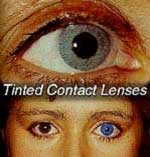
Know More...
Advances in materials technology and better understanding of the eye's needs in health and disease have enabled the development of soft and rigid lenses to aid in protecting and helping a sick eye (especially certain corneal disorders) to heal. This acts as a transparent bandage which protects the injured or diseased cornea, and acting as a reservoir of medication inserted into the eye. A variety of conditions may be treated and in some cases, even cured in this manner. These unique lenses are frequently combined with precise medication delivery schedules to help heal the eye.
Know More...
Normally the cornea is nearly spherically shaped thus allowing light to be focused clearly on the back of the eye (retina). However in a condition called Keratoconus, the cornea begins to thin, and this allows the normal pressure of the eye to make the cornea bulge forward taking on a cone-shape. As the cornea gradually becomes more cone-shaped, the vision blurs and becomes distorted. Initially vision may be correctable with spectacles, but as the condition progresses, and the cornea becomes more irregular causing distorted vision, spectacles become less effective. In such a situation, contact lenses not only provide better vision, but also help to retard the progress of the disorder. A rigid contact lens (RGP / "semi-soft" contact lenses) must be used, so that it can hold its shape, as a soft lens would simply mould to the existing shape and thus not allow complete correction of the problem. Sometimes the patient is fitted with soft lenses (for comfort), over which semi-soft lenses are fitted ("piggy-back" lenses). Recently special contact lenses called Rose K lenses have been devised which can be tailor-made to fit the "cone" in patients suffering from keratoconus. Fitting contact lenses for keratoconus requires expertise. A well-fitting contact lens dramatically improves such a patient's vision to nearly that of a normal person's, and significantly improves his or her quality of life. Any excessive pressure of a poorly fitting lens on the cone apex can cause permanent scarring within months or years (This scarring can also occur naturally). For this reason it is important for regular follow-up visits to be made so that any corneal changes that have occurred can be compensated for in the design of a new lens. It is quite common for patients to be refitted at irregular intervals as the condition progresses. Rarely, scarring is so severe that a corneal graft (transplant) is necessary.
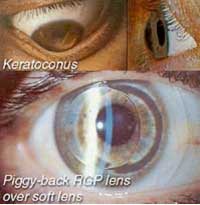
Know More...
Certain children who are born with cataracts, or develop them in early childhood, need to undergo cataract surgery. However they may be too young to be implanted with Intraocular Lenses (IOL). While surgery can protect their vision, this procedure often leaves them very farsighted. Contact lenses can provide them the best vision possible and even help their own vision develop better, since spectacles are not a practical alternative for this group.
When contact lenses are prescribed for infants and toddlers, parents and other family members can learn how to insert, remove and clean the lenses. Children of all ages can adapt easily to wearing the lenses.
Know More...
Yes, but the refractive surgery will have altered the contour of your eyes, requiring a more specialized lens than normal. It is best to consult your eye care practitioner who will advise you based on the details of your specific history and requirements.
Know More...
eye exams are important not only to check your prescription but also to evaluate the health of your eyes. This is especially important for contact lens wearers because the contacts could be causing damage to your eyes without necessarily causing any obvious symptoms. Sometimes, one may experience symptoms such as - redness of eyes, stinging, burning or itchy eyes, excessive tears, unusual eye secretions, and changes in vision. Such symptoms could be due to many reasons. On feeling of any discomfort, you should remove and examine your contact lenses immediately. If your lens appears damaged, torn or ripped, do not put the lens back on your eye. Put on a new lens or contact your eye care practitioner to order a new lens. If your lens is not damaged, but the irritation persists, contact your eye doctor immediately.
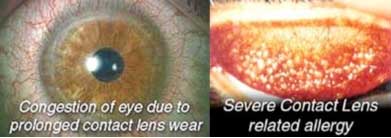
Know More...
Most people who need vision correction can wear contact lenses, but there are some exceptions. Some of the conditions that might keep you from wearing contact lenses are: frequent eye infections, severe allergies, severe dry eye (improper tear film), a work environment that is very dusty or dirty, and inability to handle and care for the lenses properly.
Whether or not contact lenses are a good choice for you depends on:
Individual needs and expectations.
Patience and motivation during the initial adjustment period to contact lens wear.
Adhering to contact lens guidelines for wear, disinfecting and cleaning.
Diagnosis and treatment of conditions that may prevent contact lens wear.
Know More...
Disposable contact lenses and frequent replacement contact lenses are designed to be worn for a specific period of time, thrown out and replaced with a fresh pair of lenses. "Disposable" refers specifically to lenses that are replaced every two weeks or less depending on the wear schedule prescribed by your optometrist or doctor. Disposable lenses are usually prescribed in multi-packs, providing several weeks supply at a time. "Frequent & planned" replacement lenses are lenses that are replaced on a planned schedule, most often either every two weeks, monthly or quarterly.
The purpose of replacing contact lenses on a frequent basis is to prevent discomfort, dryness, blurred vision and allergic reactions that can result from a build-up of protein and lipid deposits on the lenses. As the deposits age and chemically change on the lens, they contribute to these irritations. The changes in the chemical composition of the deposits also increase the probability that bacteria may adhere to a contact lens, increasing the risk of serious eye infection even without any subjective deterioration in comfort. "Disposable Lenses" and "Frequent & Planned" lenses should be discarded after the recommended replacement time even if they are still comfortable thereafter.
Your eye care practitioner will determine the lens replacement frequency that is most appropriate for you. Lenses should not be worn for longer than the recommended wearing period.
Know More...
A person is said to have 'Low Vision', if he or she has a significant visual handicap in spite of treatment and best correction with standard eyeglasses or contact lenses. 'Low Vision' should not be confused with blindness. People with 'Low Vision' have a significant visual handicap but they also have significant residual vision. The residual vision may be insufficient to meet the patient's routine needs. But a good percentage of these patients have some degree of usable vision, which can be utilized for their day to day work using special aids or devices. If properly motivated, these patients can potentially benefit with the use of special aids or devices called 'Low Vision Aids'. Shroff Eye Centre has a dedicated Low Vision Aids Service to help such patients.
Know More...
Although most often experienced by the elderly, people of any age may suffer from low vision. Low vision can result from birth defects, inherited diseases, injuries, diabetes, glaucoma, high myopia and aging.
The commonest cause is Age Related Macular Degeneration (ARMD), a degenerative disease of the retina, the innermost layer of the eye that perceives light and enables us to see. Macular degeneration affects the central vision. Even when advanced, it does not lead to total blindness because the peripheral vision is still preserved, even though the central vision may be totally lost.
Although reduced central vision is the commonest cause of low vision, extensive loss of peripheral vision as in advanced glaucoma, can also produce low vision due to extremely narrow field of vision. Birth defects or inherited disease producing loss of color vision or increased glare sensitivity (diminished ability of the eye to adjust to light, contrast or glare) can also cause low vision.
Know More...
Reduced central vision produces difficulty in reading, watching television and recognizing faces. Loss of peripheral vision reduces mobility. Increased glare sensitivity causes difficulty in driving. Impaired color vision results in difficulty in distinguishing different colors. Different types of low vision require rehabilitation with different kinds of 'Low Vision Aids'.
Know More...
A 'Low Vision Aid' (LVA) is a device or an apparatus that improves or enhances the residual vision in patients with low vision. There is no absolute level of vision above which LVAs will be useful, and below which they will not be. Also there is no one device that is suitable for all situations and all patients. Different devices are needed to fulfill the needs of various patients. Various low vision aids may need to be tried out before the most suitable device or devices is determined for a particular patient.
Know More...
There are broadly two types of Low Vision Aids: Optical and Non-Optical.
Know More...
These include: -
Large print books and magazines
Large playing cards
Large dial telephones
Enlarging photocopiers
Talking machines - talking watches, talking books, talking calculators, talking diaries & talking computers
Closed circuit televisions - these can provide high magnification (up to 40 times) in an undistorted manner. The patient can get as close as he wishes to the monitor, which may be a small or a medium sized screen of a TV or a computer monitor. Contrary to popular belief, sitting close to the screen does not cause eye damage. Adjustable magnification and contrast make it easy to use.
Know More...
Illumination has an important role in helping patients with low vision. Even for a normal person with advancing age, increased illumination is needed to perform the same task. Lighting should be ample, placed close to the reading material and be properly directed towards it. Illumination devices like high intensity reading lamps with adjustable arms are of good help.
Visors and cap brims block the dazzling effect of overhead light. Glare control filters incorporated in the spectacles can help control glare and improve function in many patients.
Know More...
At Shroff Eye Centre, a complete eye examination of patients with low vision is performed by ophthalmologists (medical doctors educated and trained to provide eye care). Total eye care to these patients starts with diagnosing the cause of low vision. Once the cause of low vision is determined, patients try out different low vision aids in a special low "Vision Aids Clinic". According to the needs of the patient, the most suitable low vision device or devices are determined and then prescribed for him or her.
Low Vision Aids assist many patients in leading a comfortable and relatively normal life. With these devices and proper motivation, people with visual loss can often read, do modified close-up work, and continue to take good care of themselves.
Know More...
 Mr. Sanjay Arora
Mr. Sanjay Arora








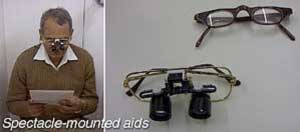
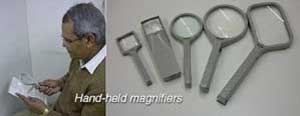
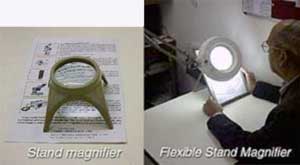
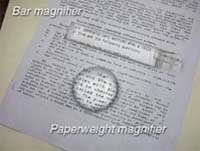
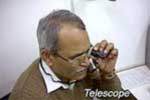



 Call Now
Call Now Book an
Book an Chat
Chat